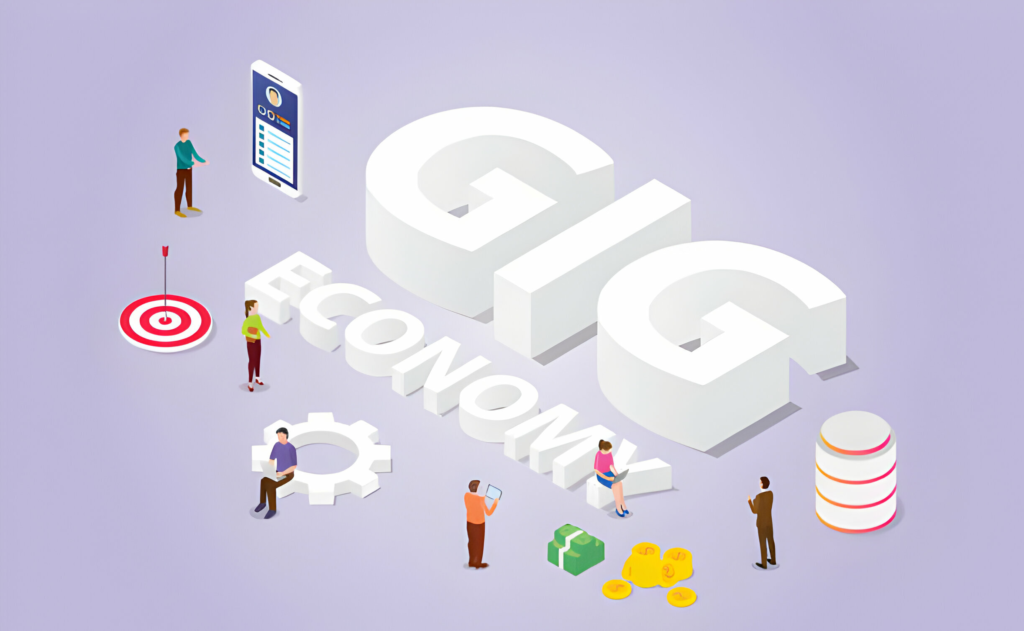
The evolving workspace has driven people to build side hustles. Today’s workforce wants to start a side business outside their primary income source to improve their finances and work for their dreams. And the growth of the gig economy is helping them set up side hustles with convenience.
The gig economy refers to an economic system where the workforce takes up contract roles or temporary jobs. Employers hire workers on a project basis or for a specific period. This approach helps them fill temporary shortages in the workforce and hire specialized gig workers. Also, they can reduce recruitment and employee benefits costs this way.
Freelance or gig workers can also leverage the industry. They can find short-term positions to increase their income. With freelancing, they can work as per their availability and have the freedom to choose roles they find suitable.

Table of Contents
ToggleMillennials and Gen Z: Key Players of the Freelance Economy
With an increase in freelancing opportunities, online gig platforms have become the go-to source to find temporary or part-time opportunities. Upwork, Fiverr, Toptal, and 99designs are popular among freelancers. Moreover, freelancing platforms focused on specific skill sets have also gained popularity.
Have you taken a look at the profiles of freelance workers on these online platforms? You may notice a majority of them belong to younger generations. Upwork published the Freelance Forward 2022 report. As per this report, 46% of Millennials and 43% of Gen Z professionals explored gig jobs in 2022.
There are a variety of reasons behind this trend:
Change in Mindset
Traditional 9-to-5 jobs have long been considered a norm. But Millennials and Gen-Zers understand the changing market dynamics.
These professionals don’t want to spend most of their waking hours on a job. Instead, they need time for things they value in life.
Many experienced professionals leave their high-paying jobs in favor of remote, flexible freelance projects. Or they want to switch off from their job after working hours which isn’t always easy with traditional jobs. With remote gigs, they can better maintain work-life balance.

Flexibility and Autonomy
Millennials and Gen-Z value flexibility and autonomy.
Many individuals wish to pursue their entrepreneurial dreams. So, with gig roles, they can build a side hustle and work with flexibility. This means they can choose when, how, and where to work.
Additionally, they have more autonomy and can choose roles as per their choice. They have control over project selection and work environment and can align their professional lives with personal preferences.
Increasing Cost of Living
The inflation rate in the US has increased to 3.4% in 2023. This is a major increase from 10 years ago (1.5%). As a result, students and young professionals suffer the most.
The increasing cost of living has forced people to look for side hustles to make ends meet. They are leading the charge and building side hustles alongside their main job. With these side businesses, they can increase their income and gain financial security.

Lack of Job Security
When it comes to traditional corporate jobs, job security is a huge concern. During the past two years, more than 28% of Americans were laid off. And 21% of US-based companies are ready to fire employees in 2024.
Thus, Millennials and Gen-Z workers are turning to gigs. With an additional income source, they don’t have to struggle financially if they end up losing their jobs.
The Impact of Covid on the Sharing Economy
The biggest boom in online work and gig jobs came with the Covid-19 pandemic. Businesses switched to remote or hybrid work mode. This created new opportunities for professionals who preferred to work remotely.
As a result of the pandemic, the demand for gig workforce increased. Small businesses in retail, hospitality, and other industries started hiring contract workers to meet employee shortages. Since Covid affected their profit rates, hiring temporary workers helped them reduce payroll costs.
Further, with a myriad of full-time employees losing their jobs, people started looking for side gigs to make a living.
Considering this demand for remote work, tech companies launched solutions to support remote work. For instance, Zoom, Slack, Trello, and Microsoft Teams experienced explosive growth. These tools introduced new features to facilitate remote collaboration.

In the post-pandemic world, short-term contracts and gig jobs remain popular. The flexible work option benefits the workforce as well as businesses.
Gig Economy: Then and Now
Side jobs and gigs have always been popular among independent contractors. People used to take up freelance and side jobs in the past too. But there has been a big transformation since the widespread adoption of the internet.
Back in the day, there were limited opportunities to find gig work. Gig economy workers relied on their personal networks to find gigs in local communities. But with online platforms, it’s far easier to find gig jobs.
You can reach global clientele and work with businesses anywhere in the world. Also, Businesses can hire professionals without worrying about their location since they can work remotely.
Similarly, online payment systems have made it easier to receive payments. These systems have eliminated the need for face-to-face transactions. Instead, clients can send payment directly into your account via wire transfer, PayPal, or other payment gateways.

Many companies are outsourcing projects. They hire freelancers with specialized skills for projects. With this practice, they can hire experienced professionals at a fraction of the cost.
Final Words
The growth of the gig economy in the recent past has been phenomenal. And technological advancements have contributed a lot to this growth.
Millennials and Gen-Z played a major role in this trend shift. They prefer flexibility, autonomy, and better work-life balance. With gig jobs, they can achieve these goals. Also, they can take up side gigs to create another source of income.
This growth in remote jobs reflects a broader shift in the mindset of today’s workforce.
